PREVIOUS
India Employment Report 2024 - Part 03
India Employment Report 2024 - Part 03
(இதன் தமிழ் வடிவத்திற்கு இங்கே சொடுக்கவும்)
Factors Influencing Rural Workforce Trends
- Prior Decline
- The decline in women's workforce participation in rural areas before 2019 was attributed to various factors.
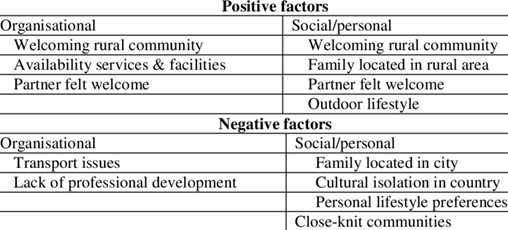
- Post-2019 Changes
- Between 2019 and 2022, there was a substantial increase in women engaging in self-employment and subsidiary roles, reflecting a need for economic activity to support their families.
Factors Influencing Women's Labour Force Participation
- Income Effect
- Changes in household income can impact women's necessity to join the workforce.
- Education Effect
- Educational attainment influences women's opportunities and motivations to participate in the labour market.
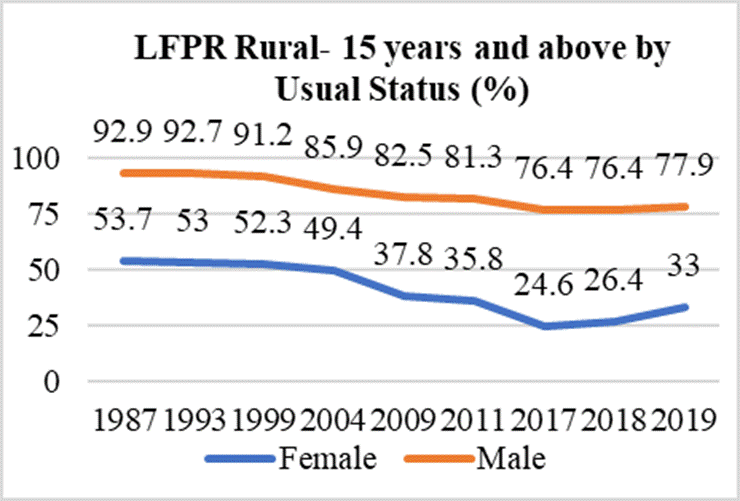
- Underreporting
- Women’s work is often underreported in official statistics, leading to an inaccurate representation of their participation.
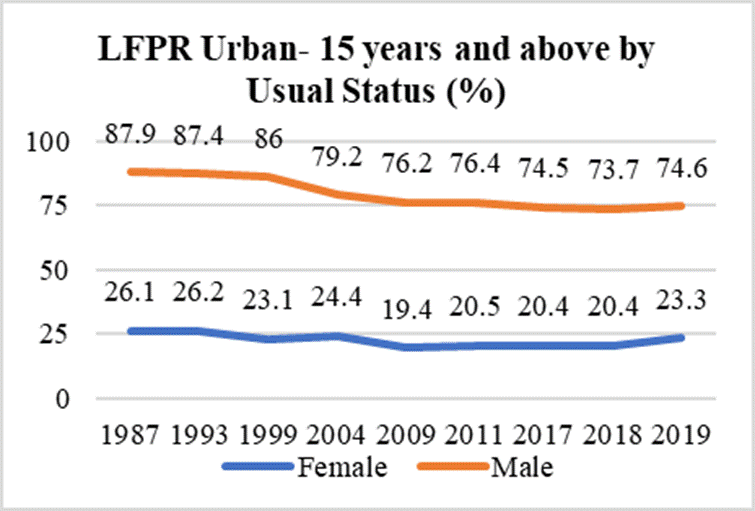
- Gender Wage Gap
- Disparities in wages between men and women discourage women's workforce engagement.
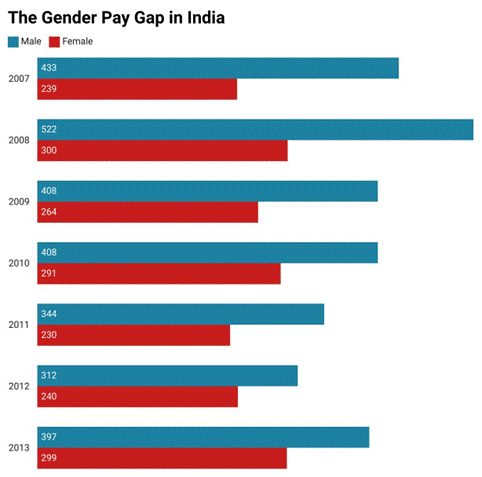
- Social and Cultural Norms
- Traditional roles and societal expectations limit women's participation in economic activities.
- Domestic and Care Responsibilities
- Responsibilities at home can restrict women’s availability for work.
Migration
- Migration patterns can affect the local labour supply of women, impacting their participation.
Time-Related Underemployment Statistics
- Current Rates (2022)
- Time-related underemployment was high at 7.5% in 2022.
- It fluctuated over the years, increasing from 8.1% in 2012 to 9.1% in 2019, then declining to 7.5% in 2022.
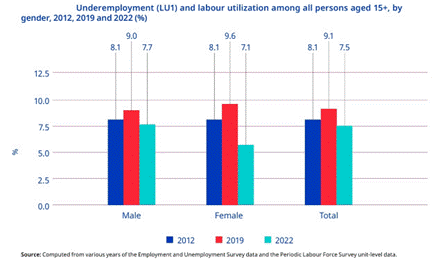
Gender Disparities
- The underemployment rate was slightly higher among men (7.7%) compared to women (7.1%) in 2022.
- Urban vs. Rural Areas
- Underemployment was more prevalent in urban areas (8.4%) than in rural areas (7.2%).
Trends and Implications
- Comparison with Open Unemployment
- Although underemployment rates were significantly higher than open unemployment, they also declined between 2019 and 2022, particularly among women (by 2.5 percentage points).
- Pre-Pandemic and Post-Pandemic Trends
- The increase in underemployment before the pandemic and the subsequent decline during and after the pandemic, especially among women, raise important questions about the availability of additional employment opportunities.
Employment and Labour Force Dynamics
- Trends from 2000 to 2012
- Workforce and Labour Force Growth
- Workforce growth and labour force growth moved in tandem during this period.
- Population Growth Impact
- A decline in the Labour Force Participation Rate (LFPR).
- A decrease in the worker population ratio.
Trends from 2012 to 2019
- Negligible Employment Growth
- Employment grew at a negligible rate, significantly below the growth of the labour force.
- Consequences
- The disparity led to:
- A rising unemployment rate.
- A further decline in LFPR and the worker population ratio.
Trends from 2019 to 2022
- Workforce growth exceeded labour force growth, which in turn far surpassed population growth.
- Outcomes
- A decrease in the unemployment rate.
- An increase in both LFPR and the worker population ratio.
Sectoral Employment Growth
- Agriculture Sector
- Trends (2000-2019)
- The agriculture workforce declined at an increasing pace.
- Reversal changes (2019-2022)
- There was a significant increase in the agriculture workforce, growing at a rate of 8.9% between 2019 and 2022.
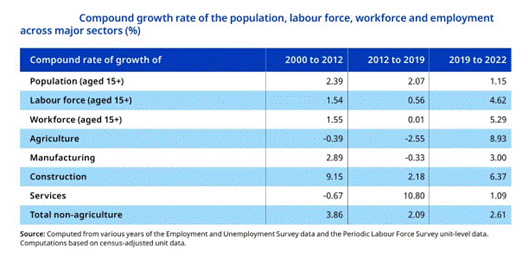
Non-Farm Employment
- Growth Rates
- Non-farm employment grew at a slightly higher rate in 2019-2022 compared to 2012-2019.
- Key Contributors
- Growth in construction employment was a major driver, with nearly 6.4% growth during the latest period.
Manufacturing vs. Services
- Manufacturing employment growth was slightly higher than the total non-farm employment growth.
- In contrast, services sector employment grew at a low rate of approximately 1.1% during 2019-2022.
Sectoral Changes in Employment and Output
- Impact of COVID-19 (2019-2022)
- The COVID-19 pandemic reversed previous trends:
- The share of the primary sector in total GVA increased from 14.8% to 15.6%.
- Employment in agriculture rose significantly from 42.4% in 2019 to 46.4% in 2021, then fell marginally to 45.4% in 2022.
- There was a corresponding decline in the share of the non-farm sector, except for construction and trade, hotels, and restaurants.
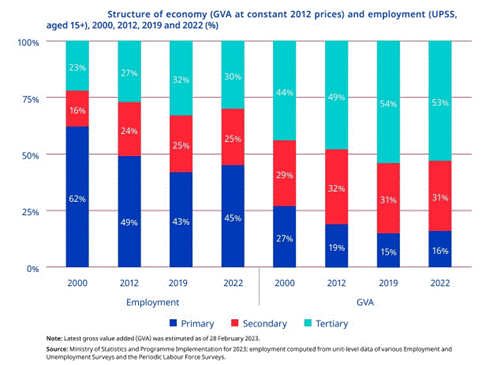
Employment Distribution (2022)
- Dominant Categories
- In 2022, the dominant category of employment in India was self-employment, which accounted for 55.8% of total employment, followed closely by:
- Casual employment: 22.7%
- Regular employment: 21.5%
- Trends (2000-2022)
- The share of self-employment remained stable at around 52% between 2000 and 2019.
- Regular employment increased significantly from 14.2% to 23.8% during the same period.
- However, by 2022:
- Self-employment increased by 3.8 percentage points to 55.8%.
- Regular employment declined by 2.3 percentage points to 21.5%.
- Casual employment consistently declined from 33.3% in 2000 to 22.7% in 2022.
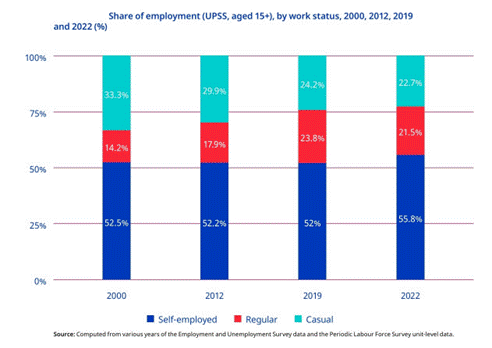
Overview of Regular Employment
- Increase in Regular Jobs: There has been a notable rise in the number of regular jobs in recent years.
- Conditions of Regular Employment
- Informality and Lack of Contracts:
- The percentage of regular workers without a contract rose significantly, from 59.6% in 2005 to 69.8% in 2019.
- This percentage decreased to 61.9% in 2022, following a loss of vulnerable regular jobs during the pandemic.
- Long-Term Contracts
- Decline in Long-Term Contracts:
- The share of workers with long-term contracts (over three years) consistently declined, from 35.9% in 2005 to 21.5% in 2019.
- This trend reversed slightly increasing to 26.4% in 2022.
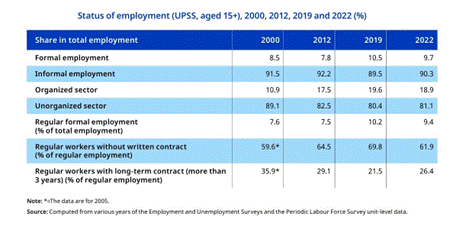
- Implications
- The recent decrease in the share of regular workers without written contracts, along with the rise in long-term contract workers, suggests an improvement in job stability for regular employment following the pandemic.
Wages and Earnings
- Average Earnings by Employment Status
- Daily Earnings:
- Significant differences exist in average daily earnings based on employment status (self-employed, regular salaried, and casual workers), gender, and location (rural or urban).
- Average Monthly Earnings (2022)
- Regular Workers: ₹19,010
- Self-Employed Individuals: ₹11,973
- Casual Workers: ₹8,267
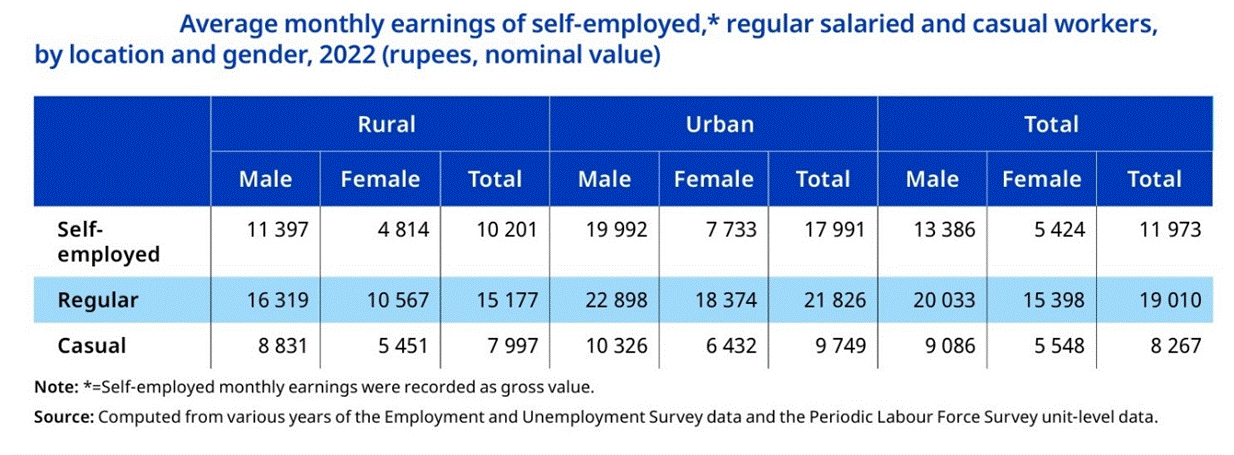
Gender Wage Gap
- Average Monthly Earnings by Gender:
- A gender gap persists in average earnings, with self-employed individuals experiencing the largest gap, followed by casual and regular salaried workers.
- Trends:
- Although the gender and rural–urban earnings gaps for regular employment have narrowed over the years, they have widened in the cases of casual work and self-employment.
Wages and Earnings Trends
- Average Monthly Real Earnings
- Regular Salaried Workers:
- Declined annually by 1.2% from ₹12,100 in 2012 to ₹11,155 in 2019.
- Continued to decline by 0.7% to ₹10,925 in 2022.
- Self-Employed Individuals:
- Experienced an annual decline of 0.8%, from ₹7,017 in 2019 to ₹6,843 in 2022.
- Casual Workers:
- Average real earnings increased by 2.4% annually, from ₹3,701 in 2012 to ₹4,364 in 2019.
- Further increased by 2.6% annually to ₹4,712 in 2022.
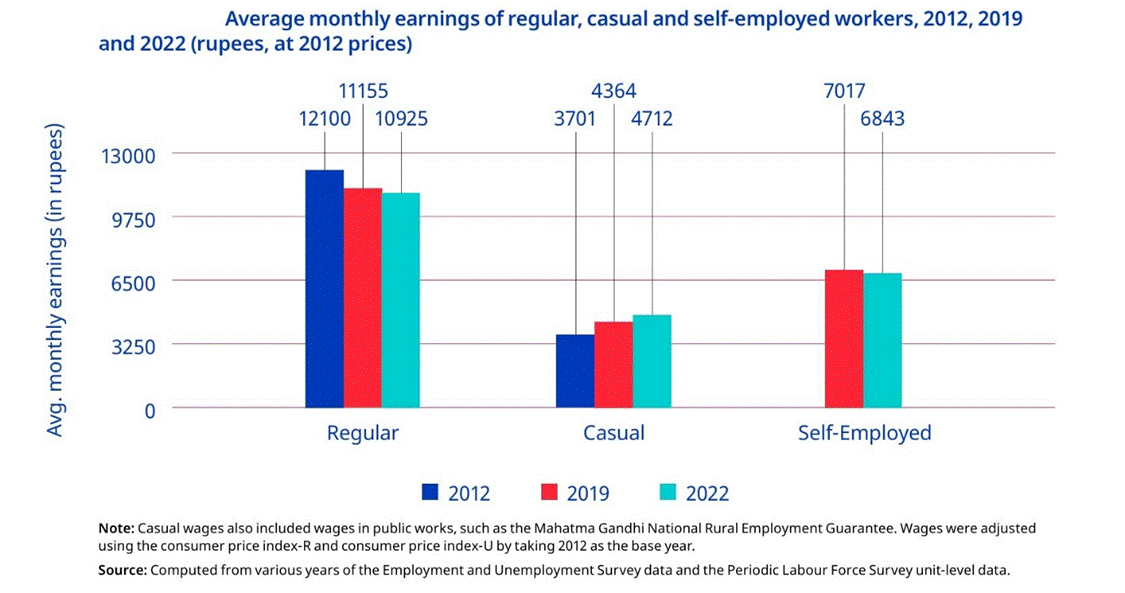
Distribution of Workers by Monthly Wages
- Regular Workers
- Wages up to ₹5,000:
- Declined from 34.6% in 2012 to 26.9% in 2022, a decrease of 7.7 percentage points.
- This shift indicates an improvement in wage distribution among regular workers.
- Casual Workers
- Wages up to ₹5,000:
- Significant decline of 42.2 percentage points, from 75.4% in 2012 to 33.2% in 2022.
- Wages above ₹10,000:
- Increased from approximately 3% in 2012 to 8% in 2022, marking a 5-percentage point rise.
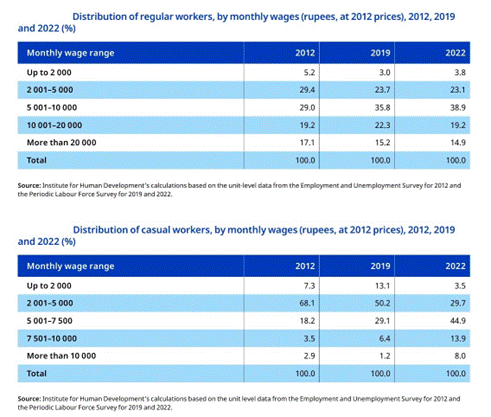
Trend in Average Monthly Wages
- Average Real Monthly Earnings
- Poorest Quintiles:
- There was a substantial rise in average real monthly earnings among the poorest quintiles over the past ten years.
- Casual workers saw a much sharper increase compared to regular workers, despite a decline in 2019.
- Regular Workers:
- Average earnings remained almost flat between 2019 and 2022.
- Casual Workers:
- Average monthly earnings increased by nearly 80% from 2019 to 2022, although this rise may be influenced by the base effect.
- Richest Quintile
- The real average monthly earnings for regular workers declined in 2022 compared to 2012.
- In contrast, earnings for casual workers in the richest quintile followed an opposite trend, indicating variability in wage growth across employment types.
Earnings Inequality
- In 2022, the ratio of average monthly earnings between the poorest and richest quintiles was:
- 12% for regular workers.
- 30% for casual workers.
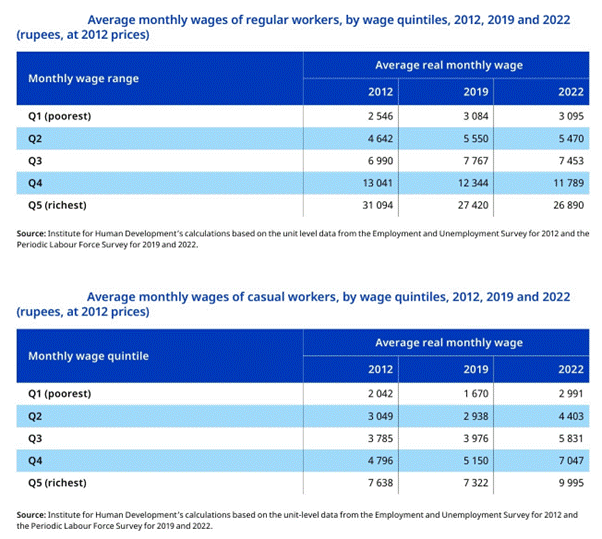
- This indicates greater inequality in earnings among regular workers compared to casual workers, which aligns with expectations based on employment stability and earning potential.
Proportion of Workers Not Receiving Minimum Wages
- The analysis based on the Periodic Labour Force Survey for 2022 reveals concerning statistics regarding the proportion of workers not receiving the minimum wages prescribed for unskilled workers in the agriculture and construction sectors.
- All-India Level
- Regular Workers:
- 40.8% did not receive the average daily minimum wage for unskilled agricultural workers.
- Casual Workers:
- 51.9% were deprived of the average daily minimum wage for unskilled agricultural workers.
- Construction Sector
- Regular Workers:
- 39.3% did not receive the average daily minimum wage for unskilled workers in construction.
- Casual Workers:
- A staggering 69.5% did not receive the average daily minimum wage for unskilled workers in the construction sector.
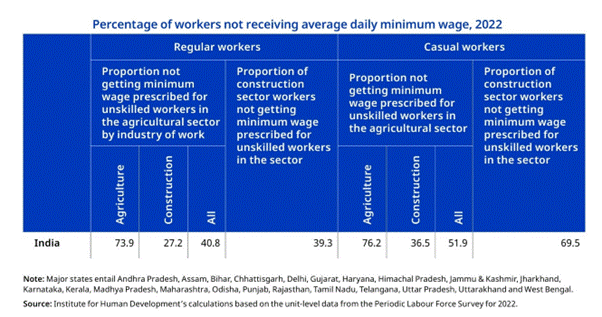
- These figures highlight significant challenges in wage compliance, particularly among casual workers, emphasizing the need for improved enforcement of minimum wage regulations.
- Participation and Earnings: Women's participation in the workforce and their earnings are substantially lower than those of men.
- A large proportion of women engage in self-employment, informal employment, or low-skill manual jobs, reflecting a stark contrast to their male counterparts.
- Educational Attainment: As of 2022, only 33.6% of women had attained secondary education or higher, compared to 44.6% of men.
- This educational gap exacerbates the challenges women face in securing better job opportunities.
- These factors underscore the significant gender differences in the Indian labour market, revealing systemic barriers that hinder women's full participation and economic empowerment.
-------------------------------------


